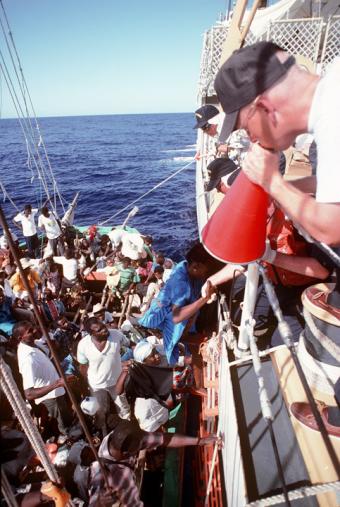PROVIDENCE, R.I. [Brown University] — The word “Guantánamo” conjures very specific but differing images, depending on who’s talking. The Guantánamo Public Memory Project, an international traveling exhibition co-curated by Brown students, seeks to broaden public perception of the U.S. naval station in Cuba and its unique history.The exhibition is coming to Rhode Island this fall.
The Guantánamo Public Memory Project has been making its way across the country and internationally for the last two years, stopping at 11 college campuses and Istanbul, London, and Brighton along the way. On Sept. 2, 2014, the Brown leg of the exhibition opens in downtown Providence at the URI Feinstein Providence Campus, which is an exhibition partner.
The exhibition, which was started by a professor at Columbia University in 2012, is made up of a core piece that includes images, documents, and stories from Guantánamo, from both the pre- and post-9-11 eras, and a section that is co-curated by the host school with a theme that changes at each location.
The Brown students who worked on the exhibition — five undergraduates and seven graduate students — under the guidance of Anne Valk, deputy director of the John Nicholas Brown Center for Public Humanities and Cultural Heritage, have spent the last two years collecting material on Guantánamo’s history of housing Cuban and Haitian refugees and the issues of immigration and human rights that history raises.
“Guantánamo means many different things to different people with a connection to the site. Cubans, who the United States defined as political refugees when they tried to escape communist Cuba, passed through Gitmo on their way to asylum in the United States, in contrast to most Haitians, who were deported back home despite the dangers that awaited many democratic activists there,” said Valk. “Many Americans do not know the story of what happened to Haitians and Cubans who sought refuge at Guantánamo in the 1990s, but the different responses of the U.S. government reveal many complexities of national security and contemporary immigration policy still relevant today.”
The exhibition also examines local connections to those issues. One display — “Who is a refugee?” — features images of the homes of undocumented immigrants taken by a local photographer. The exhibition also features work by local artists Mary Beth Meehan, Christopher Sims, and students from the International Charter School in Pawtucket.
For the project, students around the United States collected oral histories in interviews with individuals who had a personal connection to Guantánamo. Valk said the students found many people eager to share their experiences.
“People have not had the chance to share their stories. So many narratives were silenced because of the focus of post-9-11 Guantánamo. Sharing their stories was a powerful experience for many of the participants,” Valk said.
Raina Fox, who received her master’s degree in public humanities at Brown last May, worked on the project. She recalls a three-hour interview with a man from Newport whose father was stationed at Guantánamo when he was nine. He recalls an idyllic space where he was free to roam and play. She says it’s important to share perspectives that might contrast with people’s current image of Guantánamo.
“Ultimately, that’s all history is: the lens that people have.”
Students who helped co-curated local versions of the exhibition talk about their experiences.
In addition to the exhibition, which will be on display at the URI Feinstein Providence Campus building, several other activities and events have been planned for September under the title “Bringing Guantánamo Home.”
These include a film screening of the documentary Guantánamo Circus; a digital exhibit and artist lecture by Ian Alan Paul, who is part of the collaborative Guantánamo Bay Museum of Art and History; a lecture by photographer Christopher Sims, who has photographed the naval base; a teach-in featuring presentations by students and faculty who have studied Guantánamo; and a day-long conference featuring legal scholars, historians, activists, and others to discuss the exhibition’s themes of immigration and human rights.
All events are free and open to the public.
Additionally, Brown students involved in the exhibition are developing a three-day curriculum for students at Juanita Sanchez High School in Providence. They’ll discuss issues raised by the exhibition, engage in dialogue about immigration, and take a visit to the exhibition.
A full schedule and descriptions of each event are online.
Exhibition: Bringing Guantánamo Home
September 2-26
URI Providence Feinstein Campus
1st and 2nd Floor Lobby Galleries
80 Washington St., Providence
Digital exhibit and artist lecture by Ian Alan Paul
September 11 at 3 p.m.
Brown University, Rockefeller Library
Patrick Ma Digital Scholarship Lab
10 Prospect St.
Exhibition opening reception
September 11 at 5 p.m.
Screening of the documentary Guantánamo Circus at 6:45 p.m.
URI Providence Feinstein Campus
Conference: New Perspectives on Guantánamo: Art, Activism and Advocacy
September 12 from 8:30 a.m. to 5 p.m.
Brown University, Watson Institute for International Studies
111 Thayer St., Providence
Registration is required.
“Photographing GTMO and the Pretend Villages of Iraq and Afghanistan”
A lecture by Christopher Sims
September 17 at 5:30 p.m.
Brown University, Nightingale-Brown House
357 Benefit St., Providence
Gallery Night Providence: “Bringing Guantánamo Home,” with contributing artists
September 18
URI Providence Feinstein Campus, Paff Auditorium
80 Washington St., Providence
Guantánamo Teach-In
September 22 at 7 p.m.
Brown University, Stephen Robert ’62 Campus Center, The Underground
The College Green
Panel Discussion: Who is a Refugee? What makes a Refuge?
Rhode Island Stories of Immigrants and Refugees
September 25
URI Providence Feinstein Campus, Paff Auditorium
80 Washington St., Providence

